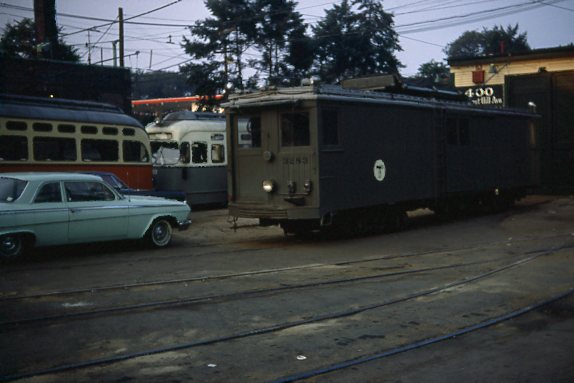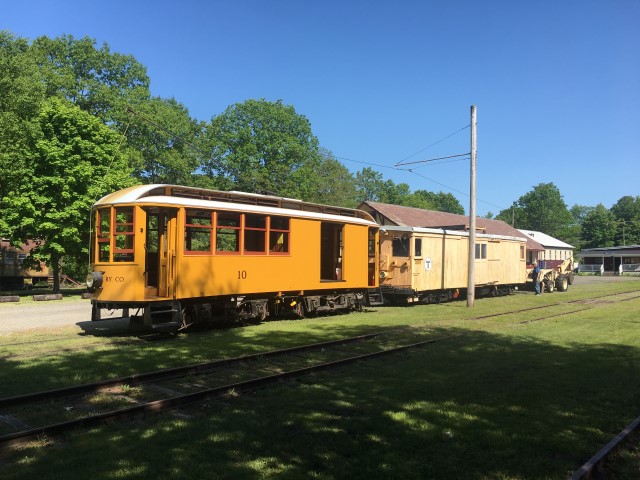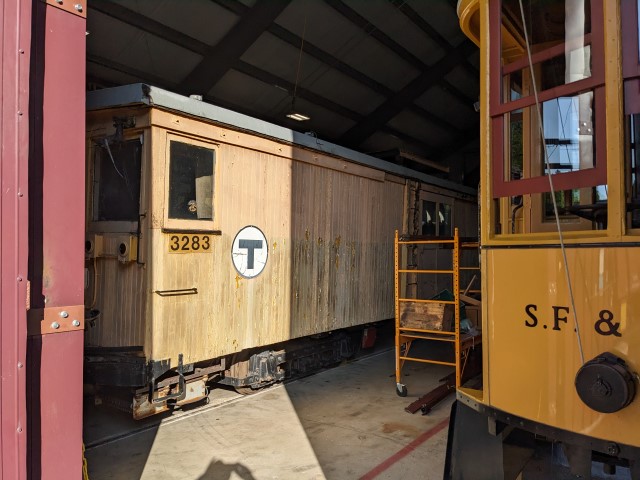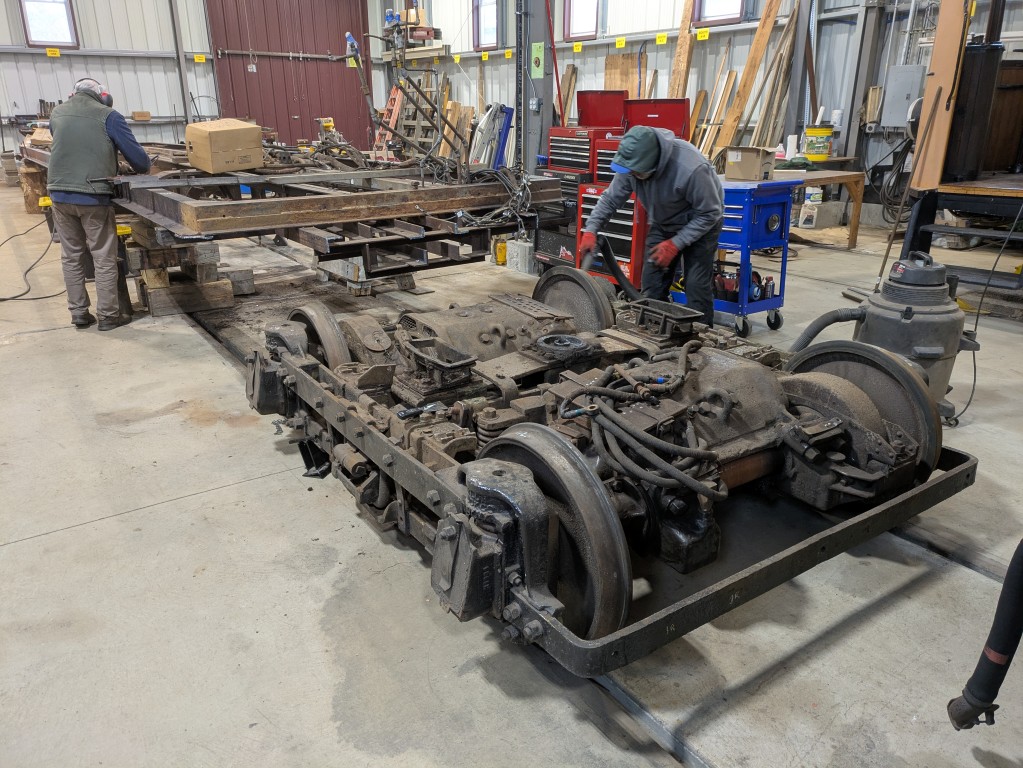
MTA/MBTA Line Car 3283 arrives at SFTM May 2023
Shelburne Falls Trolley Museum



Seashore Trolley Museum (Kennebunk Maine) donated MBTA Line Car 3283 to us in 2023. They have two other line cars and didn't feel that they need to keep this one.
For a number of years, SFTM has been searching for a machine to help move our heavy rail equipment around. At 46,000 pounds with four motors, 3283 is heavier and more powerful than Number 10. The car also has a large reel for storing and spooling out overhead wire, and plenty of workshop space inside (there is even a hot plate, for heating food during cold winter nights in Boston). It needs extensive roof repairs, exterior siding and electrical work.
Josh, our Restoration Manager, is leading the restoration of this car. You can reach Josh at josh@sftm.org if you'd like to volunteer to help with this project.
Although we are doing this with volunteer labor, we need funds for buying materials. Please make a Donation to the Line Car Fund.
We have received a Massachusetts Cultural Council's Cultural Facilities Fund matching grant for $33,000! Every dollar we raise up to $33,000 is matched by this grant.
This is a lot of money for us, but we have already raised over $15,000! That includes $3,500 from Amherst Railway Society Grants and $10,200 from the members of the Board of Directors. Many other members have made donations for the Line Car as well, which we can use toward the match even if they made the donation prior to the grant announcement.
So we still need $18,000 more! Can you help us reach the goal? A restored and operational Line Car will be a useful, fun and educational addition to our collection.
Please make a Donation for the Line Car Fund. Your generosity will be matched dollar for dollar by the Massachusetts Cultural Council.

SFTM's new trolley car, MBTA Line Car 3283, is quite odd as trolleys go. The purpose of a Line Car is to serve as a mobile workshop for maintaining the overhead wire. It has a movable platform on the roof that can be raised and lowered and swung out to the side to allow workers to access the overhead trolley wire for repair and maintenance. This feature will be useful to us.
From Seashore Trolley Museum's "re-homing" notice for 3283:
No. 3283 is a wood-frame Line Car built in 1950 by Henry Dow for the Metropolitan Transit Authority
(MTA), predecessor of the Massachusetts Bay Transit Authority (MBTA, 1964) and has a rich history during its
decades of service. Initially, No. 3283 operated from North Point Car House in South Boston until it closed
in 1953. The car was instrumental in constructing the Blue Line extensions to Orient Heights and
Wonderland in 1952-4 and was later used in the construction of the Riverside Line in 1957-59.
Ten years later, on October 16, 1969, 3283 started a routine late night wire maintenance trip on the Highland Branch. At 3:38AM, 3283 and Motor Flat 2026 met head on under the Washington Street Bridge near Brookline Village. The load of rails No. 2026 carried slid off the flat and nearly halfway through No. 3283, while the large reel of trolley wire moored in the center of No 3283 broke loose and rolled forward. No. 2026 lost its leading cab with no. 3283 receiving major damage all the way back to the center door. No. 2026 and No. 3283 were so tightly jammed together they could not be separated at the scene. One crew member was killed and sixteen others injured. The cause of the accident was found to be sloppy dispatching and alcohol use by the crews on both cars.
Being without a line car, the MBTA borrowed Seashore's former Claremont Railway Line Car No. 4. No. 3283 was rushed to the Everett Shop and returned to service in December 1970. No. 3283 continued its routine career until March 1992, when it received damage to the fuse panel area from a minor fire. Sent to the Watertown Carhouse Shop for moderate repairs, an inspection revealed major rot on the roof, deteriorated wiring and a non-functioning line tower. No. 3283 received a complete overhaul and returned to line department service on April 9, 1993. By early 2005 it was decided the car needed another major overhaul, and was taken out of service early that year. Following two years of non-action, in September 2007 No. 3283 was moved to Maine to join Seashore Trolley Museum's non-accessioned collection.
Car 3283 is the youngest U.S.-built wooden trolley still in existence. It is a copy of a pre-existing car, Line Car 3279. The Metropolitan Transit Authority (MTA, a predecessor of the Boston MBTA) ordered the body of 3283 in 1949 from the Henry E Dow company, a company that never built another trolley car, as it was primarily a builder of kit houses. It was made out of wood since wood is an excellent insulator - a very important trait for a car designed to work on the overhead wire.
Kevin Farrell tells us: From 1950 to 1958, Line car 3283 would travel all over the existing street railway system in Boston. I recall seeing it at the Mattapan Yard in 1953, when they were doing some wire work on the Mattapan-Ashmont line. After 1958, when the trolley system had been greatly reduced, Line Car 3283 was usually kept at a storage track, in front of the 1894 era, Reservoir Carhouse in Brookline to be ready for service on what became the Green Lines including the trolley subways and the Highland Branch to Riverside. On Monday through Thursdays, Line car 3283 would usually head inbound to Boston about 1:00AM, after the last regular service trolley had departed. The crew would stop at Coolidge Corner, (Beacon and Harvard Streets, Brookline.) and the crew would go into a late-night cafeteria for a quick breakfast. The car would sit there, amid street lights and the 1912 era trolley stations on Beacon Street.
MBTA 3283 line car, then painted dark grey and rail car 2026 crashed into each other in the wee hours of the morning in 1969. [This was] the last time two wooden streetcars crashed together. The result was Claremont Railway line car #4 was brought down from Seashore to Everett, fixed up and served the MBTA Green Lines for a while. Later #4 came down again, around 1975-1976 to assist in converting the Green Lines overhead to accept both pantograph and poles. The MBTA was able to get the work done much faster with a second line car and their own crews.
Note the two red markers on each end of the car. In 1950 when the car was being assembled at Everett Shops, they went out to the scrap line and took off what parts they needed. The red markers are off of two 4400's, (ex Eastern Mass Street Ry 7000's)(another famous Massachusetts street railway system) which were being scrapped in 1950. Trucks and motors were taken from a Center Entrance car. Headlights came off some other car on the scrap line. When they were doing wire work on the High Speed line, 3283 was painted all orange until about 1966 when it was repainted all dark grey. When rebuilt after the 1969 crash, it and other work cars were painted yellow. Usually it was parked on a stub end track in front of the 1894 vintage Reservoir Carhouse at Cleveland Circle.
Kevin further explains that the car was originally (1950) built with Brill 77EX trucks, but they were swapped in about 1972 for a pair of Taylor BERH trucks.
After those 1969 repairs, 3283 continued doing line work until 2005, when it was found to be in need of a heavy overhaul. At that point, the car was retired and placed behind the shops, and in 2007 was donated to Seashore. Seashore used the car as a line car for several years, and it was in use as late as 2014. However, electrical and roof issues sidelined the car in the mid 2010s.


Although we are doing this with volunteer labor, we need funds for buying materials. Please make a Donation to the Line Car Fund.







If you have, or know of, other images of MTA/MBTA 3283, please email trolley@sftm.org.
Josh, our Restoration Manager, is leading the restoration of this car. You can reach Josh at josh@sftm.org if you'd like to volunteer to help with this project.
Although we are doing this with volunteer labor, we need funds for buying materials. Please make a Donation to the Line Car Fund.
How do you move a trolley car? One option is to use Silk Road Trucking. They have special stretch lowboy trailers with rails on the beds.
Although we are doing this with volunteer labor, we need funds for buying materials.
Please make a Donation to the Line Car Fund.
We will occasionally post pictures and information on our progress with restoring 3283 to an operating Line Car.
3283 had been stored outdoors for years. The original (or likely a replacement) canvas roof had been covered over with a new fiberglass roof. This roof had cracked and was passing and trapping moisture in the old roof layers and in the frame of the car itself. Also, the mechanism for raising the platform on the roof allowed water into the walls and floor of the car. We knew rot, rust and moisture was a problem but the extent was only obvious when we started removing the roof. We removed seven layers of roof, roof walks, roof boards and roofing material. Even after six weeks under cover in our Car Barn, the purlins and carlines (like rafters for the roof) were still damp.
As we removed the siding to examine the water damage to the wooden superstructure, we found that parts of the steel frame had been extensively rusted. This was in part due to the roof problems, but also because the car has large side doors on each side, and one door had been missing for years.
At this point we realized that we needed to replace some of the steel frame, by cutting out the rusted parts and welding in new material. This necessitates removing all the wooden parts of the car so we can safely weld on the steel frame.
We are documenting the disassembly of the car and keeping the wooden frame parts for repair or replacement. The roof structure (carlines and purlins) will need to be mostly replaced. The roof sheathing and (at this point) canvas roof will need to be all new, as will the side sheathing.
Below are some pictures of our progress as of Summer 2023.
Although we are doing this with volunteer labor, we need funds for buying materials.
Please make a Donation to the Line Car Fund.
Please send any additional information or corrections or pictures to Sam Bartlett.
This car is not open to the public.
Seashore posted some pictures and comments when the car left their museum.

Here is 3283 when she arrived in late May 2023.
Ellie Flint Photo

The truck is disconnected and driven to the rear to operate the winch.
Ramps are assembled to roll the car onto our tracks.
Ellie Flint Photo

We used the tractor to pull 3283 away so the truck could be reconnected and driven away.
We fashioned a drawbar for No. 10 and used No. 10 to move 3283 into the Car Barn.

Now 3283 can keep No. 10 company in our Car Barn.
Restoration Updates:
Summer 2023
- Fall 2023
- Fall 2024
- Spring 2025
- Fall 2025
- Winter 2025

The lifting platform and several layers of roof have been removed here.
We disposed of about 4 tons of wet, rotten roofing and siding.
The roof is completely removed. The mechanism to the left is the overhead wire reel.
We used the crane to remove entire sections of the wooden frame for safe disassembly on the floor.
Here half of the roof framing and walls have been removed. Also showing the wire reel, which will be saved for re-installation.
3283 looks more like a flat car than a line car here.
Much of the steel under-frame is solid, the rusted out parts don't show here.
Parts of this half of the roof may be salvagable.
Most of the two "A end" side frames can be reused.
Close up of the rusted-out side frame section that needs to be replaced.
Most of the floor has been removed and only part of the "A" end wall is left.
And look, we've moved the Line Car into the extended Car Barn!
All the wooden parts have been removed, ready for work on the steel underframe.

Dick and Larry have prepped, primed and painted the brake rigging.

Josh grinds down some welds on the frame repair.

Here the end beam has been replaced, part of the side beam removed and a new piece awaits installation.

Nash inspects the wiring while Dick and Phil prep the frame.

New frame members, primed and ready for the curved bumper/anti-climbers to be built and installed.

A close-up of the z-channel for the frame, welded from angle and plate.

We jacked up on end of the frame and pulled out a truck for better access.
Restoration Updates:
Summer 2023
- Fall 2023
- Fall 2024
- Spring 2025
- Fall 2025
- Winter 2025
The Shelburne Falls Trolley Museum exists due to the generosity of members, visitors and friends. Tickets cover about one-third of our operating costs. Donations are tax-deductible, the museum is a 501(c)(3) organization, run entirely by volunteers. Our Tax ID is 04-3133373. Feel free to research our operation at Guidestar.org.
To make a financial donation, please send a check made out to "SFTM",
to:
Shelburne Falls Trolley Museum
PO BOX 272
14 Depot Street
Shelburne Falls, MA 01370
If you wish you may designate your donation for a specific SFTM project in the memo line of your check:
General Fund,
Car Barn Extension,
"Berkshire Hills" Parlor Trolley,
MBTA PCC Cars,
B&M Box Car,
MBTA Line Car 3283,
CV Caboose 4015
or Volunteer Appreciation.
The General Fund is available for us to use to cover our costs of operation (insurance, electricity, etc.) or, if we have enough, we can transfer it to one of the other project funds.
After you click the "Donate" button below you may designate your donation for a specific SFTM project:
General Fund,
Car Barn Extension,
"Berkshire Hills" Parlor Trolley,
MBTA PCC Cars,
B&M Box Car,
MBTA Line Car 3283,
CV Caboose 4015
or Volunteer Appreciation.
The General Fund is available for us to use to cover our costs of operation (insurance, electricity, etc.) or, if we have enough, we can transfer it to one of the other project funds.
14 Depot Street Shelburne Falls MA 01370 413-625-9443 trolley@sftm.org